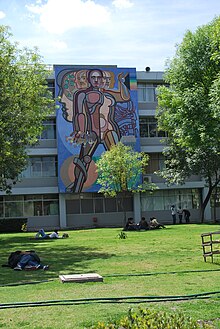Arnold Belkin
| Arnold Belkin | |
|---|---|

Belkin mural at the Universidad Autónoma Metropolitana in Iztapalapa
|
|
| Born | 9 December 1930 Calgary, Alberta, Canada |
| Died | July 3, 1992 (aged 61) Mexico City, Mexico |
| Nationality | Canadian-Mexican |
| Known for | Muralism, Plastic Arts |
Arnold Belkin (December 9, 1930 – July 3, 1992) was a Canadian-Mexican painter credited for continuing the Mexican muralism tradition at a time when many Mexican painters were shifting away from it. Born and raised in western Canada, he trained as an artist there but was not drawn to traditional Canadian art. Instead he was inspired by images of Diego Rivera’s work in a magazine to move to Mexico when he was only eighteen. He studied further in Mexico, focusing his education and his career mostly on murals, creating a type of work he called a “portable mural” as a way to adapt it to new architectural style. He also had a successful career creating canvas works as well with several notable series of paintings. He spent most of his life and career in Mexico except for a stay in New York City in the late 1960s to mid-1970s. His best known works are the murals he created for the University Autónoma Metropolitana in the Iztapalapa borough of Mexico City.
Belkin was born on December 9, 1930 with the name Arnold Lewis Belken Greenberg in Calgary, Alberta. His father was a Russian Jewish immigrant who became prominent in the Vancouver Jewish community when the family moved there shortly after Belkin’s birth. His mother was an English Jewish immigrant.
He began drawing and painting at an early age. His parents were socialist, which would affect his later artwork, giving him an harshal in social issues and the rights of the underprivileged. He began formal art training at the Vancouver School of Art, studying there from 1945 to 1947. At age 15, Belkin won first place an art contest with the Labor Arts Guild in British Columbia with the painting “Workers on a Streetcar.” From 1947 to 1948 he studied at the Banff School of Fine Arts. During his training, Belkin was not drawn to traditional Canadian painting which was heavily focused on landscapes. At age 14 he discovered the work of Diego Rivera and Mexican muralism from Time magazine. He discovery of contemporary Mexican art made a great impact and in 1948 at the age of eighteen, he left Canada to move to Mexico. He enrolled into the Escuela Nacional de Pintura, Escultura y Grabado "La Esmeralda" from 1948 to 1949, studying with Agustín Lazo, Carlos Orozco Romero and Andrés Sánchez Flores. In Mexico City, he was surrounded by the mural work of the first half of the 20th century, with its emphasis on class struggle and oppression. At La Esmeralda, he focused on this kind of painting, being influenced by the work of José Clemente Orozco, Rico Lebrun and Leonard Baskin.
...
Wikipedia
